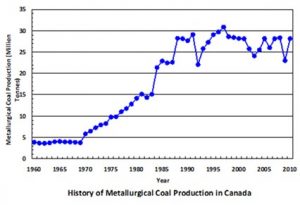 Canadian coal exports doubled over the 1980s. Research was aimed at reducing the cost of coke and energy for Canadian steelmakers and finding a global niche for Western Canadian coal. With Canadian coke batteries aging, PCI work became very important to coal and steel members. The PCI facilities at Bells Corners was proving its value in the injection program. A CCRA sponsored project at the University of British Columbia on coke oven modeling was completed and the model now resides at CANMET for all to use.
Canadian coal exports doubled over the 1980s. Research was aimed at reducing the cost of coke and energy for Canadian steelmakers and finding a global niche for Western Canadian coal. With Canadian coke batteries aging, PCI work became very important to coal and steel members. The PCI facilities at Bells Corners was proving its value in the injection program. A CCRA sponsored project at the University of British Columbia on coke oven modeling was completed and the model now resides at CANMET for all to use.
In 1995, CCRA celebrated its 30th anniversary. Because of difficult economic conditions in the Canadian coal and steel industries, membership had declined to eight members and EMR was undergoing a program review. As a result, CCRA was asked to prepare an impact statement for their review.
By 1997, the CCRA/CANMET fee structure underwent a significant change with confidential oven test work increasing substantially. The Board of Directors approved By-law Number 2 to create a new category of Membership, the Connected Member. This was a category for members who were not financially eligible to join as full members but wished to be part of CCRA.

